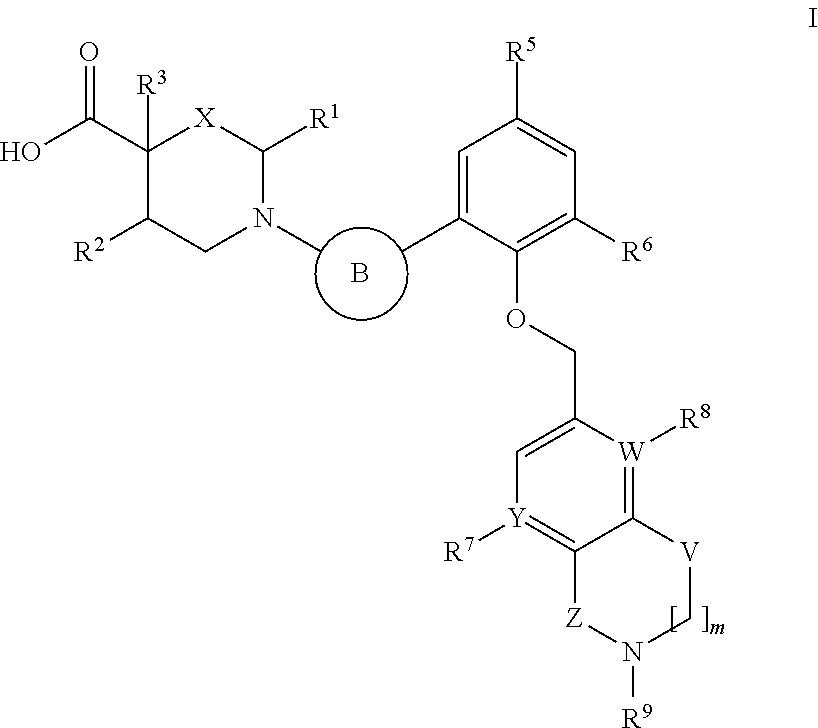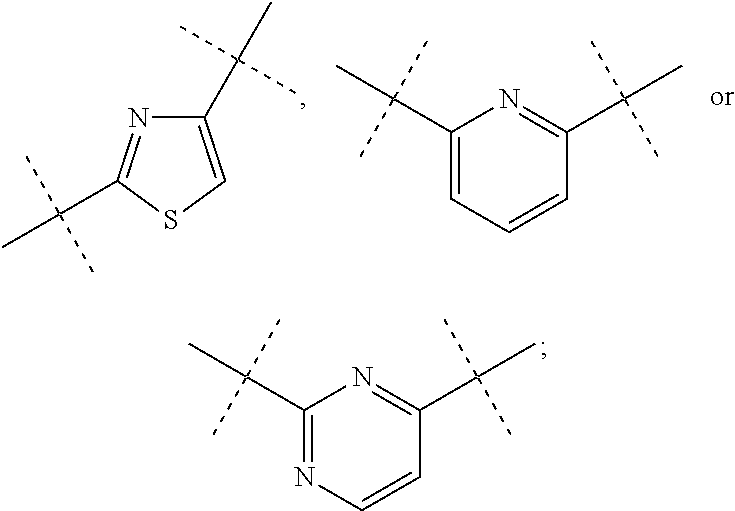Heterocyclic carboxylic acids as activators of soluble guanylate cyclase
a technology of soluble guanylate and carboxylic acid, which is applied in the direction of cardiovascular disorders, drug compositions, metabolic disorders, etc., can solve the problems that poor human exposure to poor soluble compounds, and achieve the effects of reducing iop, inhibiting prostatic, urethra and bladder smooth muscle cell proliferation, and increasing secretion ra
- Summary
- Abstract
- Description
- Claims
- Application Information
AI Technical Summary
Benefits of technology
Problems solved by technology
Method used
Image
Examples
example 1
Preparation of intermediate (S)-3-Aza-bicyclo[4.1.0]heptane-6-carboxylic acid ethyl ester (A-1)
[0236]
[0237]To a stirred solution of 21% NaOEt in EtOH (53.3 mL, 148.2 mmol) in anhydrous EtOH (100 mL), at 0° C., is slowly added diethylmalonate (25 g, 156 mmol). Following the addition, the reaction mixture is warmed to room temperature and allowed to stir until the solid material is dissolved. Then, (R)-epi-chlorohydrine (10.8 mL, 140.5 mmol) in EtOH (5 mL) is added drop wise. The mixture is refluxed for 36 h and then allowed to cool to room temperature and diluted with water. The volatile organics are removed under reduced pressure and the resulting residue is extracted with EtOAc. The combined organic extracts are dried (Na2SO4), filtered and concentrated under reduced pressure. The residue is first purified by flash silica gel chromatography to afford the crude product which is taken up in toluene (100 mL) and treated with K2CO3 (5.1 g, 37.0 mmol). The mixture is heated at 110° C. f...
example 2
Preparation of intermediate (R)-3-Aza-bicyclo[3.1.0]hexane-1-carboxylic acid methyl ester (A-2)
[0248]
[0249]To a solution of 21% NaOEt solution (53 mL, 150 mmol) in EtOH (100 mL), cooled to 0° C., is added diethylmalonate (25 g, 16 mmol). When the mixture becomes thick, additional EtOH (50 mL) is added and the mixture is warmed to room temperature and kept stirring until all solids have dissolved. To the mixture is added, drop wise, a solution of (R)-epichlorohydrin (10.8 mL, 140 mmol) in EtOH (5 mL). After the addition, the mixture is heated to reflux for 36 h and then, cooled to room temperature and diluted with water. The solution is extracted with EtOAc and the combined extracts are dried over anhydrous Na2SO4 and concentrated under reduced pressure. The residue is purified by flash silica gel chromatography to afford A-2-1(13.5 g, 51% yield).
[0250]To a solution of A-2-1 (11.5 g, 68 mmol) in EtOH (150 mL) is added sodium borohydride (1.9 g, 51 mmol). The resulting mixture is stir...
example 3
Preparation of intermediate (1R,2R)-2-Methyl-3-aza-bicyclo[3.1.0]hexane-1-carboxylic acid methyl ester (A-3) and (1R,2S)-2-Methyl-3-aza-bicyclo[3.1.0]hexane-1-carboxylic acid methyl ester (A-4)
[0255]
[0256]A solution of benzyl amine (11.2 g, 104 mmol) and crotonitrile (7.0 g, 110 mmol) in EtOH (125 mL) is heated to reflux for 24 h. The mixture is cooled to room temperature and concentrated under reduced pressure. The residue is purified by flash silica gel chromatography to afford A-3-1 (13 g, 73% yield).
[0257]A solution of A-3-1 (13 g, 74 mmol) and (R)-glycidol (11 g, 150 mmol) in EtOH (100 mL) is heated to reflux for 2 days. The mixture is cooled to room temperature and concentrated under reduced pressure. The residue is purified by flash silica gel chromatography to afford A-3-2 (13 g, 71% yield).
[0258]To a solution of diol A-3-2 (11.5 g, 46.0 mmol) in DCM (150 mL), cooled to 0° C., is added TEA (29 mL, 232 mmol) followed by sulfonic anhydride (24 g, 140 mmol). The solution is war...
PUM
 Login to View More
Login to View More Abstract
Description
Claims
Application Information
 Login to View More
Login to View More - R&D
- Intellectual Property
- Life Sciences
- Materials
- Tech Scout
- Unparalleled Data Quality
- Higher Quality Content
- 60% Fewer Hallucinations
Browse by: Latest US Patents, China's latest patents, Technical Efficacy Thesaurus, Application Domain, Technology Topic, Popular Technical Reports.
© 2025 PatSnap. All rights reserved.Legal|Privacy policy|Modern Slavery Act Transparency Statement|Sitemap|About US| Contact US: help@patsnap.com



